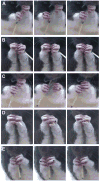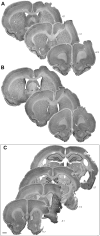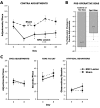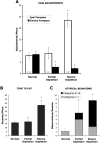The vermicelli handling test: a simple quantitative measure of dexterous forepaw function in rats
- PMID: 18325597
- PMCID: PMC2394277
- DOI: 10.1016/j.jneumeth.2008.01.015
The vermicelli handling test: a simple quantitative measure of dexterous forepaw function in rats
Abstract
Loss of function in the hands occurs with many brain disorders, but there are few measures of skillful forepaw use in rats available to model these impairments that are both sensitive and simple to administer. Whishaw and Coles previously described the dexterous manner in which rats manipulate food items with their paws, including thin pieces of pasta [Whishaw IQ, Coles BL. Varieties of paw and digit movement during spontaneous food handling in rats: postures, bimanual coordination, preferences, and the effect of forelimb cortex lesions. Behav Brain Res 1996;77:135-48]. We set out to develop a measure of this food handling behavior that would be quantitative, easy to administer, sensitive to the effects of damage to sensory and motor systems of the CNS and useful for identifying the side of lateralized impairments. When rats handle 7 cm lengths of vermicelli, they manipulate the pasta by repeatedly adjusting the forepaw hold on the pasta piece. As operationally defined, these adjustments can be easily identified and counted by an experimenter without specialized equipment. After unilateral sensorimotor cortex (SMC) lesions, transient middle cerebral artery occlusion (MCAO) and striatal dopamine depleting (6-hydroxydopamine, 6-OHDA) lesions in adult rats, there were enduring reductions in adjustments made with the contralateral forepaw. Additional pasta handling characteristics distinguished between the lesion types. MCAO and 6-OHDA lesions increased the frequency of several identified atypical handling patterns. Severe dopamine depletion increased eating time and adjustments made with the ipsilateral forepaw. However, contralateral forepaw adjustment number most sensitively detected enduring impairments across lesion types. Because of its ease of administration and sensitivity to lateralized impairments in skilled forepaw use, this measure may be useful in rat models of upper extremity impairment.
Figures







References
-
- Adkins DL, Campos P, Quach D, Borromeo M, Schallert K, Jones TA. Epidural cortical stimulation enhances motor function after sensorimotor cortical infarcts in rats. Exp Neurol. 2006;200:356–70. - PubMed
-
- Adkins DL, Voorhies AC, Jones TA. Behavioral and neuroplastic effects of focal endothelin-1 induced sensorimotor cortex lesions. Neuroscience. 2004;128:473–86. - PubMed
-
- Allred RP, Jones TA. Unilateral ischemic sensorimotor cortical damage in female rats: forelimb behavioral effects and dendritic structural plasticity in the contralateral homotopic cortex. Exp Neurol. 2004;190:433–45. - PubMed
-
- Ballermann M, Metz GA, McKenna JE, Klassen F, Whishaw IQ. The pasta matrix reaching task: a simple test for measuring skilled reaching distance, direction, and dexterity in rats. J Neurosci Methods. 2001;106:39–45. - PubMed
Publication types
MeSH terms
Substances
Grants and funding
LinkOut - more resources
Full Text Sources
Research Materials

